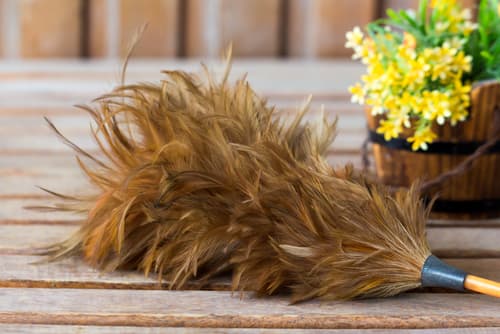When it comes to cleaning, the right tools can make a real difference. No place is this more evident than with your dusting tools. But feather dusters, lambswool dusters, and microfiber dusters can be the most perplexing to clean. Don’t worry – Castle Keepers is here to help!
How do you clean lambswool dusters?
Thanks to the natural lanolin in lambswool fleece, lambswool makes an excellent duster. Lanolin is a waxy substance secreted by glands on the skin of wool-bearing animals. Most dusters move dust around and release it back into the air, but when lambswool moves over a surface, the dust clings to the lanolin like a magnet and holds it in the duster itself. Lambswool does not have an electrostatic charge and is therefore safe for dusting computers and electronics.
How do you use a lambswool duster?
While dusting, you should remove dust from the lambswool duster every few minutes by shaking it close to the floor or tapping it against your foot. This action knocks extra dust to the floor to be vacuumed up later. After each use, vigorously shake the duster outside to get rid of excess dust. You can also put your vacuum cleaner on low suction and use the hose to clean your lambswool duster gently.
Can a lambswool duster be washed?
When your lambswool duster starts to look dirty, it can be hand washed in a sink of warm water with a small amount of mild soap and rinsed in clean water to remove any soapy residue. Lambswool should be dried gently with a towel until damp and then left to air dry completely on a dry towel or hung upside down. Once dry, spin the duster’s handle between your palms to restore the lambswool to its original fullness.
How do you care for a lambswool duster?
After several washes, you may wish to add a few drops of glycerin, a water-soluble moisturizer, to the rinse water to restore the ability of the wool fibers to attract dust. You can also purchase pure lanolin to apply to the wool fiber of your lambswool duster. The process is not as quick and easy as adding glycerin to the wool, but it seems to last longer and be more effective for dusting. Add a very, very small dab of lanolin to the palm of your hand and rub them together to spread the lanolin over the palms and fingers of both hands. Then rub your hands all over the wool duster to evenly distribute the lanolin throughout the fibers.
How do you take care of an ostrich feather duster?
 If you plan on dusting fragile or expensive objects, get the best duster for home cleaning made from genuine ostrich feathers. Thousands of soft, tiny filaments on each feather attract and trap dust by static electricity. Most soils (sand, silt, clay, and organic matter) and germs (bacteria and viruses) carry an overall negative charge. All the feather filaments rubbing against each other produce an electrostatic charge, which attracts the negatively charged dust. The dust then becomes trapped between the filaments as the duster is gently drawn across the surface.
If you plan on dusting fragile or expensive objects, get the best duster for home cleaning made from genuine ostrich feathers. Thousands of soft, tiny filaments on each feather attract and trap dust by static electricity. Most soils (sand, silt, clay, and organic matter) and germs (bacteria and viruses) carry an overall negative charge. All the feather filaments rubbing against each other produce an electrostatic charge, which attracts the negatively charged dust. The dust then becomes trapped between the filaments as the duster is gently drawn across the surface.
How do you get dust out of a feather duster?
While dusting, the cleaning procedure is the same as for lambswool dusters – shake or tap the duster near the floor so you can vacuum up any dust not trapped in the duster later. When finished dusting, shake the ostrich feather duster outside to rid it of any loose dust before you store it for its next use.
Should you wash an ostrich feather duster?
To wash an ostrich feather duster:
- Fill a sink with warm water and a tiny amount of mild dishwashing liquid.
- Place the duster in the solution and gently swirl it back and forth until all the feathers are separated.
- Rinse the feather duster in clean water and gently squeeze out excess water by hand.
- Wrap the feathers in clean, dry towels until barely damp.
- Hang the duster upside down outside or in a place with good air circulation to fully dry.
- Once dry, spin the ostrich feather duster’s handle between your palms to restore the static electricity in the duster.
How do you clean a microfiber duster?
Microfiber dusters are fantastic multipurpose tools and are good for dusting and polishing while either dry or damp. They have a unique woven structure that allows their tiny fibers to pick up dust and dander with no sprays or polishes needed. In addition, dry microfibers have an electrostatic charge that makes them an excellent choice for dusting.
Is it better to dust with a wet or dry microfiber duster?
Add a bit of plain tap water to your microfiber and, even though it no longer has an electrostatic charge, all the tiny microfibers do an even better job of picking up and trapping dust, especially in neglected rooms. Please don’t get your microfiber duster too wet because it works best when only slightly damp. Remember that microfiber is not the best choice for applying oil or wax furniture polish. These products clog the microfibers and may interfere with laundering.
What is the best type of microfiber duster?
You can purchase several different types of microfiber dusters:
- General-purpose microfiber cloth, either in hand towel form or sewn to fit over a bendable extension wand.
- Chenille microfiber duster where the microfibers are woven into the shape of chenille “fingers,” which increase the surface area of the duster head so it can catch and remove even more dust than general-purpose microfiber cloth.
- Microfiber dusters designed to look like feather dusters and mimic the gentle nature of both feathers and lambswool.
Can you machine wash microfiber dusters?
 You can wash your microfiber duster after each use instead of waiting for them to look dingy, like with lambswool or feather dusters. Microfiber is highly durable, and even after hundreds of washes, it is still effective for both wet and dry cleaning jobs. For best results, wash microfiber dusters separately as they easily pick up lint from other materials, especially cotton terry cloth. Microfiber can go straight into the washing machine with warm or hot water (a temperature of around 130 degrees F opens up the fibers to release dirt) and a mild detergent.
You can wash your microfiber duster after each use instead of waiting for them to look dingy, like with lambswool or feather dusters. Microfiber is highly durable, and even after hundreds of washes, it is still effective for both wet and dry cleaning jobs. For best results, wash microfiber dusters separately as they easily pick up lint from other materials, especially cotton terry cloth. Microfiber can go straight into the washing machine with warm or hot water (a temperature of around 130 degrees F opens up the fibers to release dirt) and a mild detergent.
Please don’t use bleach for laundering microfiber unless the manufacturer specifically says so, as it will damage the microfiber and shorten its usable life. Tumble the microfiber dusters dry on a low or medium dryer setting or allow to air dry, as high heat will melt the fibers. Do not use fabric softeners with microfiber cloths because fabric softeners coat the tiny threads, thus clogging the tiny filaments and eliminating the electrostatic charge that makes microfiber so effective.
Where can I find reliable cleaners who use high-quality tools?
If you hire top-rated professionals to keep your home in check, you don’t have to worry about cleaning your supplies again. Here at Castle Keepers, you can rest assured that your home will be in competent hands. We bring our own efficient cleaning equipment and use expertise-based techniques to get every task done right.
Would you like a trained specialist to eliminate bad odors from your home, take excellent care of your wooden furniture pieces, or eliminate candle wax staining from your linen? Rely on our punctual, friendly, and knowledgeable cleaners and forget about doing chores yourself!






